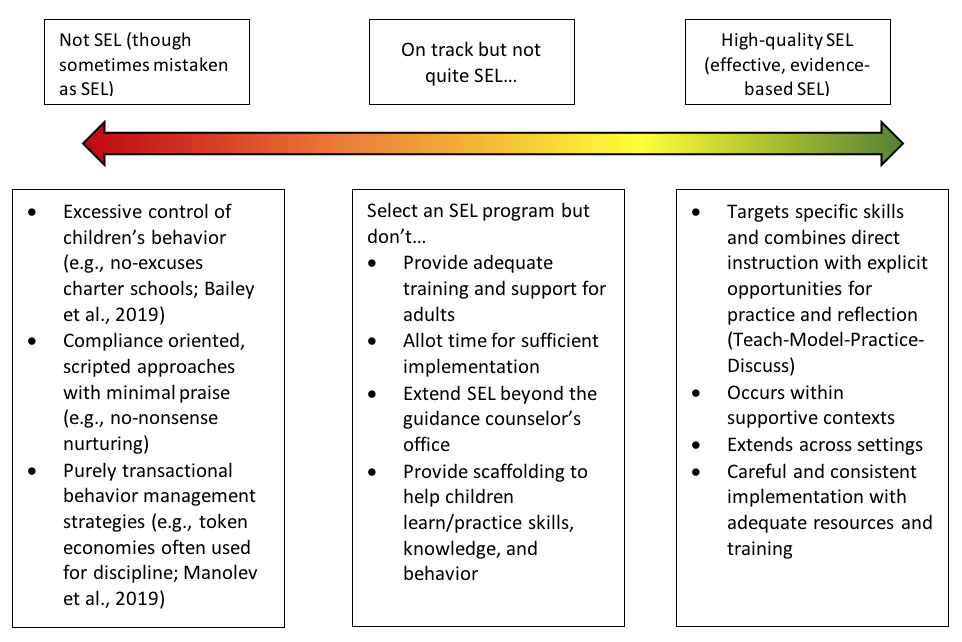Yes, Petting a Guinea Pig Can Be SEL, if It’s Done Effectively
Posted by admin on

“Is Petting a Guinea Pig SEL?,” Rick Hess recently asked in a post about what feels like an ever-growing list of programs and strategies intended to cultivate social and emotional learning in schools. The method he highlights aims to build SEL skills through interaction with pets in the classroom. The question Hess asks is valid, but to address it in earnest, we need to look beyond any specific approach and return to what we know about the science and practice of SEL. We’ve written about this in the past (See “Social-Emotional Learning: What It Is, What It Isn’t, and What We Know” and “An Antidote to the ‘Fever’ of Social and Emotional Learning: Build from Science and Evidence, and Ask the Right Questions.”) Here, we describe the spectrum of SEL approaches and what constitutes high-quality programs, strategies, or practices.
What Is Effective SEL?
Research and our own experience working with schools and teachers indicate that SEL initiatives are most effective when they do the following. These basic components are elements of high-quality instruction in any topic—academic and extracurricular.
Follow the Teach-Model-Practice-Discuss Structure. The most effective SEL efforts target specific skills and combine direct instruction with explicit opportunities for practice and reflection. For example, in our own work, we encourage adults to engage in the following approach to SEL:
- Teach: Adults clearly name SEL concepts, vocabulary, and skills and provide children with explicit instruction in developmentally and culturally appropriate ways.
- Model: Adults both model and live the skills and attitudes they hope to see in children.
- Practice: Adults and settings provide opportunities for and capitalize on real-life openings for children to practice skills (i.e., integrate skill practice into everyday activities and interactions).
- Discuss: Adults take the time to talk with children about what happens when a challenge arises, identify skills they can use to address the challenge, and reflect on how the episode went.
Direct instruction in SEL can take many different forms, including role-play, games, books and stories, song and dance, discussions, and yes—even caring for pets! The key is to make the skill being cultivated explicit in one way or another. These experiences might be part of a structured SEL program or occur organically throughout the day. Regardless of the instructional approach, the key is to make explicit, discuss, and reflect on what is being learned during these activities.
Occur within a Supportive Context. We know that learning environments that are safe, secure, enriching, and conducive to developing positive relationships promote SEL skill development and the use of SEL skills. Schools, classrooms, and other learning environments that best support children to learn and use SEL skills include a combination of activities, routines, and procedures that build SEL skills and establish prosocial norms for both children and adults (e.g., calm-down corners and listening sticks for young children, or classroom agreements and goal-setting checklists for older youth). Even the best SEL efforts are unlikely to be successful when implemented in schools or classrooms that feel unsafe or unpredictable.
Extend across Settings. Effective SEL programming should provide continuous, consistent opportunities to build and practice skills across settings, including at home and in the community. Many approaches to SEL focus on one setting, such as a guidance counselor’s office, classroom, or extracurricular activity. However, SEL skills are important for navigating all areas of a school, particularly the unstructured ones such as playgrounds, lunchrooms, hallways, bathrooms, and buses. SEL skills are also needed at home and out in the world. Non-classroom contexts provide vital opportunities for students to apply SEL skills learned in the classroom to real-life situations, helping to solidify those skills into everyday tools and habits.
Support High-Quality Implementation. The success of SEL initiatives relies on more than just putting in place a strong, evidence-based set of strategies or curriculum—research shows that how carefully and consistently they’re implemented plays a critical role in how effective they are. High-quality SEL implementation includes providing sufficient staff support and training (including opportunities for adults to develop their own SEL skills); allotting sufficient time and resources to plan and execute SEL efforts effectively, and ideally in a manner aligned and integrated with other instructional plans; facilitating ownership and buy-in from staff, students, and families; and using data to guide decision-making. SEL activities are often seen as optional or secondary, and are often abridged in ways that limit their effectiveness, or are skipped entirely. Schools have limited time and many competing priorities, but investing in SEL alongside academics ultimately supports improved academic performance, behavior, and attitudes about school.
The SEL Continuum
Based on the features of effective SEL described above, programs claiming to be SEL or SEL-related tend to lie on a continuum from “Not SEL (though sometimes mistaken as SEL)” to “High-quality SEL (effective, evidence-based SEL).”
On the left we highlight approaches that are not SEL, though sometimes claim to be or are misinterpreted as such. Though these approaches are often oriented around classroom or behavior management, they are problematic as they run counter to what research tells us about children’s social and emotional development. Reactive and exclusionary discipline policies, for example, inhibit children’s abilities to build and practice self-regulation skills and jeopardize the relationships between students and teachers.
In the middle, we note those that are taking steps towards implementing evidence-based SEL, but don’t yet have key infrastructure, support, or implementation plans in place.
And finally on the right, we underscore the key features of high-quality SEL implementation, providing guidance to those in the yellow zone hoping to improve SEL efforts in their settings.

So, is petting a guinea pig SEL? Lasting social and emotional development certainly could happen when children have the opportunity to care for a pet in the classroom, but in the absence of stronger evidence about that specific program, we just don’t know. What we do know is that having a guinea pig in the classroom without the elements we’ve described cannot accurately be called SEL. It is also unlikely to be effective. It could even be harmful to children and the field if expectations are set and not achieved. Conducting rigorous studies requires a lot of time, money, and other resources that many smaller organizations—even those with good ideas—don’t have. But what we do know is that if a program meets the components of effective SEL described above and is implemented correctly, it’s more likely to produce positive results.
Stephanie M. Jones is Gerald S. Lesser Professor of Child Development and Education at the Harvard Graduate School of Education and an author of Navigating SEL from the Inside Out, Looking Inside & Across Leading SEL Programs: A Practical Resource for Schools and OST Providers (Preschool and Elementary Focus and the Middle and High School Focus). Sophie P. Barnes is a Doctoral Candidate at the Harvard Graduate School of Education. Katharine Brush is a Senior Research Manager at the Ecological Approaches to Social and Emotional Learning (EASEL) Lab at the Harvard Graduate School of Education and a co-author of the Navigating SEL guides.
The post Yes, Petting a Guinea Pig Can Be SEL, if It’s Done Effectively appeared first on Education Next.
